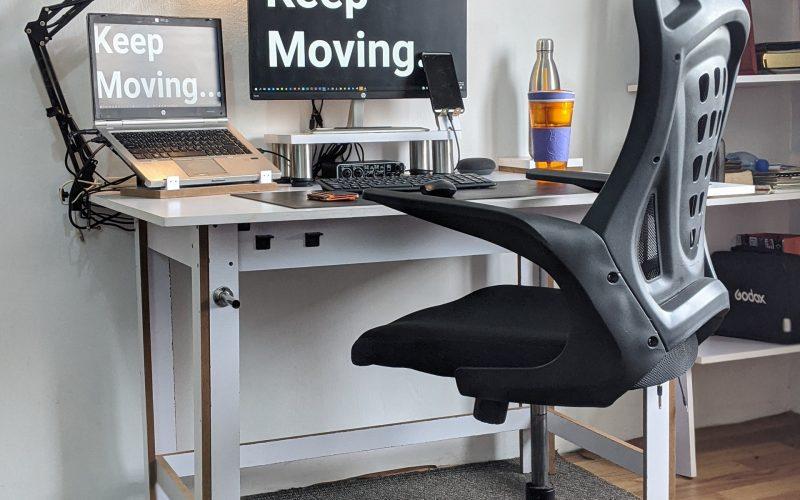
Working prolonged hours on a poorly designed worktable, you may experience pain in the neck and shoulders, discomfort in the back, hands, wrists, eyestrain, and headaches. Simple ergonomic adjustments in your workstation can avoid aches and injuries that disrupt effective production.
The non-ergonomic environment at your workplace can cause health issues, such as the sore back, carpal tunnel syndrome, flu, and chronic cold. Wrong body postures, improper lifting of heavy items, pushing and pulling heavy objects at the workplace can affect the muscular and nervous systems, causing musculoskeletal disorders (MSDs).
With more and more online interactions, most of the digitised offices support tech-savvy employees with computer workstations. Ergonomic workstations at work will protect employees from health problems such as tendinitis, rotator cuff injuries, back injuries, and muscle strains.
For Maintaining Healthy Posture
Learning to maintain a healthy posture while at the worktable avoids problems happening because of uncomfortable seating and sitting. Working for long hours in bad posture can cause injuries to the muscles, nerves, and pain in the limbs.
Healthy posture at work prevents neck pain, backaches, fatigue, varicose veins, and cardiovascular ailments. It helps in the proper alignment of joints, bones, muscles, ligaments, tendons, and nerves as well.
Adjusting your chair height, sitting upright
Modern offices prefer ergonomic office chairs for their employees. The ergonomic chairs have options to adjust the seat depth, seat angle, armrests, and flexible spring stiffness if there is a reclining feature. Take care to adjust the height of the chair to rest your feet flat on the floor.
Most desks in the office come at a fixed height. So, it is better to adjust the height of your chair to maintain the correct position of your hands and arms.
With a flat stool to support your feet, the thighs can rest at the edge of the seat to make your sitting comfortable without strain.
Desk height and positioning
Most desks available today have the option of adjusting according to the comfort level of the user. Here are a few tips to check if your desk height is in position.
- The height of your desk matches your sitting posture.
- The desk has the adequate height to pull your chair in without your knees knocking at the furniture
- You must be able to pull forward your computer monitor so that there is no need to lean and strain while working
Setting up your Keyboard and Mouse
Maintaining a neutral hand position helps to minimise the strain on your wrist and hands. Your keyboard should be within reach to keep your hands and forearms straight. It will also help you not to lean forward to use the keyboard.
If you have to type more, keep the keyboard close to you so that your arms and shoulders are in a comfortable position.
Place your keyboard and the mouse at a comfortable distance so that there is enough space to support your wrists. It also avoids unnecessary stretching, which can strain your arms and shoulders and force you to bend your wrists abnormally.
Setting Monitor Level
While sitting and working at the worktable, you must not strain your neck, back, and shoulders. Positioning the computer monitor at eye level helps to keep your neck and head in a balanced position. Your elbows must be at a 90-degree angle level with your shoulders comfortably resting at your sides while working at the system.
Comfortable Monitor Brightness
Just as maintaining distance between the monitor and your eyes, take care of the brightness in the monitor. The monitor brightness should be equal to the brightness of the environment behind it.
With the workstation in areas with highly contrasting light, the uneven brightness can induce headaches, fatigue, and eyestrain. Alter the light settings in your monitor by checking how the brightness at the workstation changes throughout the day.
Alternatively Use a Standing desk
Once in a while, standing and working at your electric sit-stand desk helps to relax your limbs. But standing on your feet may put more strain than sitting on your body.
Some tips to consider if you prefer using a standing desk. The desk must be tall enough to rest your arms comfortably. The computer monitor must be fixed at your eye level. The keyboard and mouse are placed closely near each other to maintain the neutral position of your wrists and hands. Get up and move around at least once in an hour or two.
Following Active Sitting
Active sitting helps your leg muscles, abdominal muscles, and muscles at the back to be active. Standing desks or bouncy ball chairs help you move, yet tasks at workstations require sitting at least for a while.
To maintain an ergonomic workstation at home, adjust the position of your chair in a way that supports your lower back. Place a rolled towel or a pillow at the base of your chair to provide more lumbar support to your back muscles.
Choose a chair with considerable height to rest your elbows at a 90-degree angle. While sitting, allow your feet to touch the floor or use support to rest your feet. Keep changing your posture regularly. Sit upright or sit reclined or sit declined for a while to change your sitting patterns to avoid aches and pains.
Using Footrest
We pay attention to our hands and wrists at our workstations. Similarly, we must pay attention to feet as well. Using an adjustable footrest while sitting and working at the computer may not be familiar to so many. But, your active sitting includes using your footrest also, and it facilitates movement.
A simple stool or foot bar or the cushion or the leg rest can help your feet rest at a comfortable height that relieves pressure on the back, knees, legs, and feet. It improves blood circulation and maintains your energy levels as well. A dynamic footrest gives comfortable space for your feet to rest and stretch out with ease.
Taking Frequent Breaks
Make it a routine to take regular breaks at least once every one hour. It is good if you walk, stretch and change positions to avoid health issues because of prolonged sitting at work.
Take a short walk or walk up and down the stairs for some time. Move near to the window to take a breath of fresh air. Talk to your colleague once in a while to break the monotony of working continuously.
Conclusion
Organisations at present are taking the much-needed initiative to provide ergonomic workstations to their employees.
A small effort to set up ergonomic workstations reduces workplace-related injuries and maintains a healthy work environment. With proper posture, appropriate chairs, and worktables, employees can work comfortably, safely, and effectively from wherever they are.





